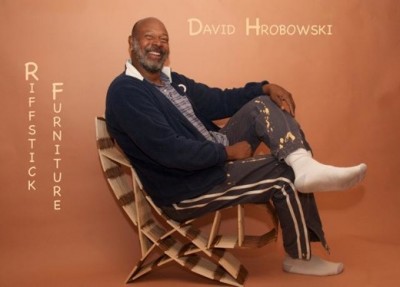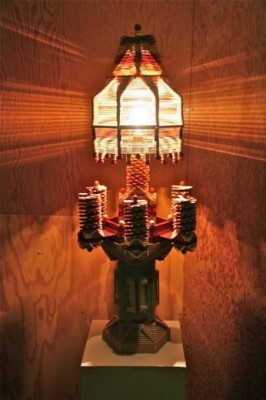What to Do With Thousands of Popsicle Sticks
/https://tf-cmsv2-smithsonianmag-media.s3.amazonaws.com/filer/20110520090125IMG_9603-321x400.jpg)
In 1905, the story goes, an 11-year-old named Frank Epperson forgot a container of soda water outside with a stick in it that froze in place. Eighteen years later he began selling fruit-flavored versions of his accidental invention as Eppsicles—later changed to Popsicles.
It probably wasn't long afterward that the first popsicle-stick craft was made. The flat, oblong planks of white birch wood make ideal materials for miniature log cabins or handles for homemade puppets. Crafty 20th-century hobos also found them useful, along with other found materials, for creating works of so-called tramp art.
Then there are the elaborate pieces of furniture made entirely of Popsicle sticks and Elmer's glue by Los Angeles artist David Hrobowski, who recently had his first exhibition at MorYork gallery in the L.A. neighborhood of Highland Park.
With the awareness in recent decades that our planet has a garbage overflow problem, objects made of recycled or repurposed trash have come back in vogue. DIY magazines like ReadyMade can show you how to turn your empties into a chandelier or wine crates into cabinets.
Although Hrobowski isn't actually using recycled sticks—he would have to eat thousands of Popsicles for each piece of furniture—consider his work an example of the potential of simple, everyday food-packaging materials.

Like the Popsicle inventor himself, Hrobowski's inspiration dates back to his childhood. When he was nine and had to stay home sick from school for several days, he says, a thoughtful neighbor brought him some popsicle sticks and glue to give him something to do. He built a lamp and shade that were impressive enough that he was featured on the local news. He made another half-dozen, selling them for $15 a piece. Then he forgot about them.
Forty years later, in 2007, a friend dragged Hrobowski into a craft store on their way out to dinner. The first thing he saw was a big package of popsicle sticks. "It immediately triggered the memories," he says, of his youthful creations. He told the story of his earlier lamp-making fame, but his friend was preoccupied with his own errand and kind of dismissed him. "I was offended," he says. "If my friend had responded the way I wanted him to, I probably would have just forgotten about it again."

Instead, he bought a bunch of sticks and some Elmer's glue and set out to make another lamp. It came out well, so he made another. Then a console table. Then a mirror frame. "I was surprised," he says. "I don't know where this stuff comes from."
A friend with a shop on Melrose Avenue in Los Angeles put the set in the window display. Then Clare Graham, himself a master of recycled art, booked Hrobowski for a solo show at his non-profit gallery, MorYork. The first available slot he had was three years in the future—March 2010.
The long delay turned out to be a blessing—some pieces take hundreds of hours of work, and he can only glue a few sticks together at a time before he has to pause to allow them to dry. He calls the pieces Riffsticks, and he designs as he goes, often working on several pieces at a time. "I like the repetitiveness," he says. "It's very soothing."
He supplemented his income as an antiques dealer specializing in cufflinks with part-time and odd jobs so he could spend more time on his artwork. He eventually had more than two dozen pieces to show, including a glass-covered coffee table and a functional chair that can support the weight of an adult. Several pieces sold, and he plans to continue making more.
Don't expect to pay anywhere close to $15 for one of his pieces these days. Prices begin at $600 for a table lamp, and more elaborate pieces—like the table that took him a year and a half to complete—cost more than $20,000.
/https://tf-cmsv2-smithsonianmag-media.s3.amazonaws.com/accounts/headshot/Lisa-Bramen-240.jpg)
/https://tf-cmsv2-smithsonianmag-media.s3.amazonaws.com/accounts/headshot/Lisa-Bramen-240.jpg)